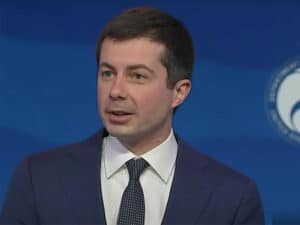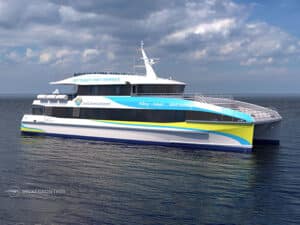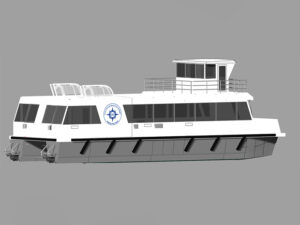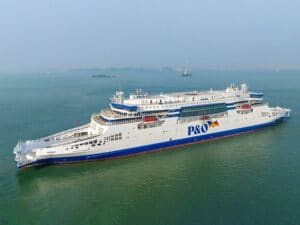
Sea Change ferry arrives in San Francisco
Written by Heather Ervin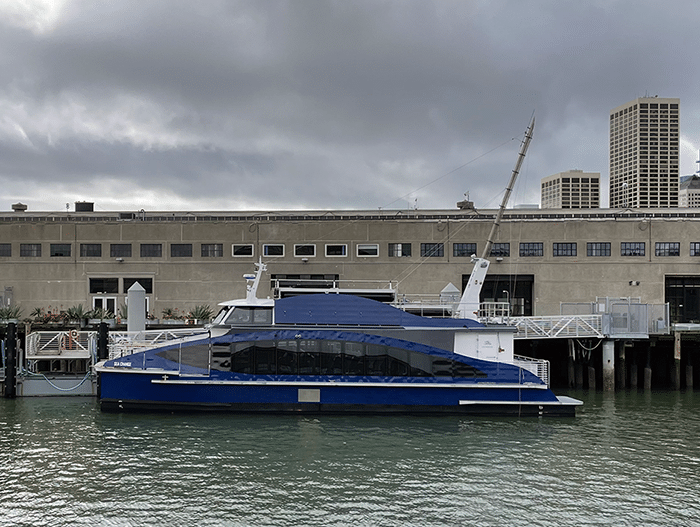
M/V Sea Change docked at Pier 9 in San Francisco (Credit: San Francisco Bay Ferry)
The highly anticipated zero-emissions ferry, the M/V Sea Change, powered by hydrogen fuel cell technology arrived in San Francisco over the weekend, where it will prepare to carry passengers later this year.
Launched in August 2021 at Bellingham, Wash.-based All American Marine, the Sea Change is a 70-foot catamaran ferry designed by Incat Crowther, equipped with a hydrogen fuel cell system from Zero Emissions Industries (ZEI), which includes 360 kW of fuel cells from Cummins and 242 kg of hydrogen storage tanks from Hexagon Purus, and a 600 kW electric propulsion system from BAE Systems that includes 100 kWh of lithium-ion battery storage from XALT. The Hornblower Group led the construction management.
The ferry will be operated by San Francisco Bay Ferry, which operates 16 vessels to California cities including Oakland, Richmond and Vallejo. The operator is working with U.S. Coast Guard officials in the Bay Area on necessary inspections and certifications needed to operate the vessel.
“We’re finalizing plans on a demonstration pilot operating M/V Sea Change, the world’s first hydrogen electric passenger ferry, in the Bay Area,” says Thomas Hall, spokesperson for San Francisco Bay Ferry. “San Francisco Bay Ferry boasts the cleanest high-speed, high-capacity ferry fleet in the nation, but we’re committed to moving toward a zero-emission future. We plan to deliver our first zero-emission battery electric ferries in the next couple of years, and we’re so excited to learn more about the potential for hydrogen fuel cells through this demonstration pilot. We look forward to announcing more, including a date when the public can ride on this state-of-the-art ferry, in the coming months.”
Ferry specifics
The 75-passenger ferry received gaseous hydrogen into its 242 kg tanks on the upper deck. It uses that hydrogen in fuel cells producing electricity to power electric motors for distances up to 300 nautical miles, and speeds up to 20 knots—similar capabilities to diesel-powered vessels—with the added benefits of zero exhaust smoke or other emissions and very little vibration and noise.
The Sea Change project is managed and financed by SWITCH Maritime, an impact investment firm building the first fleet of exclusively zero-carbon maritime vessels for adoption by existing ship owners and operators.
Sea Change was the first vessel in the larger zero-carbon ferry fleet that SWITCH planned to construct in 2022, in partnership with municipalities and shipowners aiming to transition to carbon-free vessels. In making the transition, they were able to leverage government grant funds related to transportation decarbonization activities targeted by the landmark U.S. infrastructure bill.
Though Sea Change is not the world’s first hydrogen-fueled ferry, it is the first to use gaseous hydrogen in a fuel cell, rather than burning liquid hydrogen in an internal combustion engine. Among the advantages of using gaseous hydrogen is its availability. This is underscored by the fact that the fuel loaded in the Sea Change’s tanks includes green hydrogen, produced in California by an electrolyzer powered with renewable solar power, so that zero carbon emissions result from the production of the fuel.
ZEI, formerly Golden Gate Zero Emission Marine, is responsible for the design and development of the Sea Change’s first-of-its-kind maritime hydrogen and fuel cell system as well as the vessel’s unique fueling system that allows it to be fueled directly from a hydrogen truck, and was responsible for the successful regulatory approvals of all hydrogen-related aspects onboard.
ZEI is a hydrogen technology company that develops and sells turnkey hydrogen power systems, advanced fuel cell balance of plant sub-systems, fueling systems, and proprietary safety systems for a range of applications.

